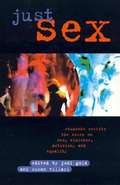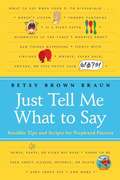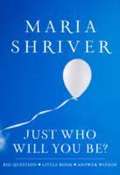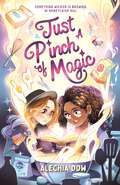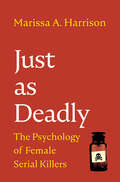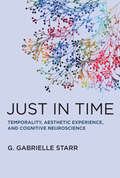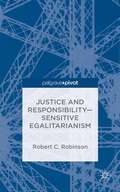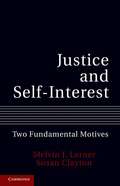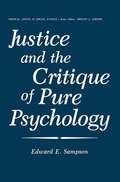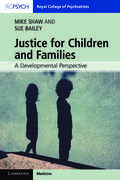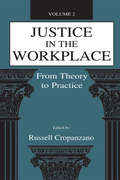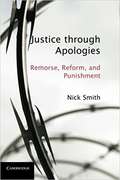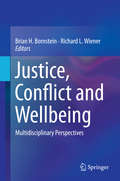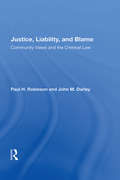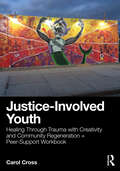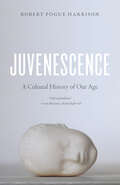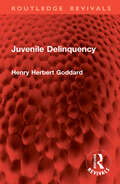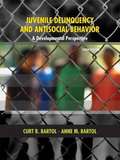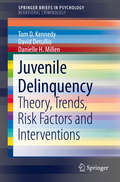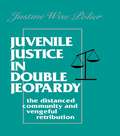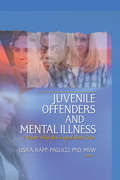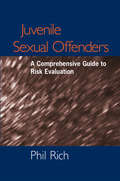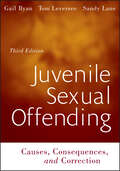- Table View
- List View
Just Sex: Students Rewrite the Rules on Sex, Violence, Equality and Activism
by Jodi Gold Susan VillariArmed with three decades of feminism, men and women are coming to college with different ideas and expectations about sexual freedom and violence than did their parents. Since the early 1980's, a student movement has emerged from the belief that sexual violence is neither inherent nor inevitable. Just Sex: Students Rewrite the Rules on Sex, Violence, Equality and Activism chronicles the move to end to all forms of sexual violence and to mold a new sexual paradigm where explicitly consensual sex and sexual autonomy are the norm. <p><p> Based on ten years of collaborative research and national organizing, Gold and Villari have compiled the writings of leading student activists and young scholars wrestling with complex issues of power inequities, free speech, and societal constructions of gender and sexuality in accessible and mainstream dialogues. Authors also examine the generationally specific style of student activism which emphasizes peer education and institutional collaboration. <p> Just Sex―the first ever gathering of primary documents including university policies, personal testimonies, position papers and scholarly essays―offers a glimpse of the "working papers" of a student movement which has altered the sexual landscape of our campuses and communities forever. This valuable volume will be of interest to student activists, administrators, and anyone interested in ending violence on and off of campus.
Just Sex?: The Cultural Scaffolding of Rape (Women and Psychology)
by Nicola GaveyIn the award-winning Just Sex? The Cultural Scaffolding of Rape, Nicola Gavey provides an extensive commentary on the existing literature on rape, analysing recent research to examine the psychological and cultural conditions of possibility for contemporary sexual violence. Just Sex? argues that feminist theory on sexual victimization has gone both too far and not far enough. It presents the reader with a challenging and original perspective on the issues of rape, sex and the body, incorporating new material on sexism, misogyny and digital culture, as well as debates over gendered analyses of sexual violence. The second edition has been updated and expanded to be extremely timely and relevant, with the most recent high-profile rape cases – the Stanford rape case and the Belfast rape case – being tried in the media and online. The rise of the Hollywood Harvey Weinstein scandal and the #MeToo movement makes this book incredibly useful and necessary to those who are working within the area of sexual violence. This will appeal to academic readers studying psychology, sociology, and criminology, as well as those looking into cultural influences on society. It will also be very useful to those working in the professional sector on prevention and with people who have been subjected to sexual violence.
Just Tell Me What to Say
by Betsy Brown BraunParents are often perplexed by their children's typical behaviors and inevitable questions. This down-to-earth guide provides "Tips and Scripts" for handling everything from sibling rivalry and the food wars to questions about death, divorce, sex, and "whyyyy?" Betsy Brown Braun blends humor with her expertise as a child development specialist, popular parent educator, and mother of triplets. Whatever your dilemma or child's question--from "How did the baby get in your tummy?" to "What does 'dead' mean?" to "It's not fair!"--Betsy offers the tools and confidence you need to explain the world to your growing child.
Just Who Will You Be? Big Question, Little Book, Answer Within
by Maria Shriver"I've learned that asking ourselves not just what we want to be, but who we want to be is important at every stage of our lives, not just when we're starting out in the world. That's because in a way, we're starting out fresh in the world every single day." Just Who Will You Be? is a candid, heartfelt, and inspirational book for seekers of all ages. Inspired by a speech she gave, Maria Shriver's message is that what you do in your life isn't what matters. It's who you are. It's an important lesson that will appeal to anyone of any age looking for a life of meaning. In her own life, Shriver always walked straight down her own distinctive path, achieving her childhood goal of becoming "award-winning network newswoman Maria Shriver". But when her husband was elected California's Governor and she suddenly had to leave her job at NBC News, Maria was thrown for a loop. Right about then, her nephew asked her to speak at his high school graduation. She resisted, wondering how she could possibly give advice to kids, when she was feeling so lost herself. But in the end she relented and decided to dig down and dig deep, and the result is this little jewel. Just Who Will You Be? reminds us that the answer to many of life's question lie within -- and that we're all works in progress. That means it's never too late to become the person you want to be. Now the question for you is this: Just who will you be?.
Just a Little Too Thin: How to Pull Your Child Back from the Brink of an Eating Disorder
by Meg Schneider Michael StroberAt a time when 81 percent of ten-year-old girls say they are afraid of being fat, early dieting is clearly a widespread problem. <P><P> However, the difference between being "just a little too thin" and having a full-blown eating disorder can be hard for even the most involved parent to distinguish. Dr. Michael Strober and Meg Schneider's Just a Little Too Thin shows parents how to approach this problem proactively. First, it helps parents determine the severity of a child's weight issues by outlining the three stages of this slippery slope and the behavioral signs associated with each. The book then gives expert guidance on talking about weight and eating in ways that help a daughter cope with the emotional issues that feed her obsession. No matter where a girl rests on the continuum of eating behaviors, Just a Little Too Thin is an invaluable aid for parents intent on keeping their children emotionally and physically healthy in a world of unprecedented pressures.
Just a Pinch of Magic
by Alechia DowJust a Pinch of Magic, Alechia Dow's middle-grade debut, is as warm and sweet as a cinnamon bun, bursting with magic and sure to please the pickiest readers.Wini's family of enchanters runs a little bakery, but with the prices of magical ingredients skyrocketing, they're going under. Desperate to save her family's business, Wini takes a risk by casting a (sort of illegal) spell that would allow them to gather their own supply of their most needed magical ingredient: Love. But the spell doesn't work. And Wini soon discovers that it didn't just not work, it backfired. Badly. Now the whole town is in danger, and the Enchantment Agency is sniffing around for whoever cast the wayward spell.It's just been Kal and her dad for as long as she can remember. They've weathered everything together, including Kal's mental health struggles. But just as they're about to move to a new town for a fresh start, Kal's grandfather—who mysteriously vanished years ago—has suddenly reentered their lives with a desire to make amends. He joins them in opening their bookstore in the new town, but Kal can't help but wonder if he has anything to do with the whispers around her new home about wicked magic. And it's not just the whispers of the magical books in their shop.When Wini and Kal cross paths—both hoping for the chance to finally make a friend without worrying about their family histories following them—the girls bond over being fellow outcasts. Together they search for the solution to fixing the magic gone awry in their beloved town—and just maybe get their dads to go out on a date.Includes five recipes!Praise for Just a Pinch of Magic:"Just a Pinch of Magic provides more than a pinch of fun. This delightful middle-grade debut is full of friendship, adventure, magic—and recipes!" —Janae Marks, New York Times-bestselling author of On Air with Zoe Washington
Just as Deadly: The Psychology of Female Serial Killers
by Marissa A. HarrisonYou've heard of Ted Bundy and John Wayne Gacy. But have you heard of Amy Archer-Gilligan? Or Belle Gunness? Or Nannie Doss? Women have committed some of the most disturbing serial killings ever seen in the United States. Yet scientific inquiry, criminal profiling, and public interest have focused more on their better-known male counterparts. As a result, female serial killers have been misunderstood, overlooked, and underestimated. In this riveting account, Dr. Marissa A. Harrison draws on original scientific research, various psychological perspectives, and richly detailed case studies to illuminate the stark differences between female and male serial killers' backgrounds, motives, and crimes. She also emphasizes the countless victims of this grisly phenomenon to capture the complexity and tragedy of serial murder. Meticulously weaving data-based evidence and insight with intimate storytelling, Just as Deadly reveals how and why these women murder—and why they often get away with it.
Just in Time: Temporality, Aesthetic Experience, and Cognitive Neuroscience
by G. Gabrielle StarrLiterature and neuroscience come together to illuminate the human experience of beauty, which unfolds in time.How does beauty exist in time? This is Gabrielle Starr&’s central concern in Just in Time as she explores the experience of beauty not as an abstraction, but as the result of psychological and neurological processes in which time is central. Starr shows that aesthetic experience has temporal scale. Starr, a literary scholar and pioneer in the field and method of neuroaesthetics, which seeks the neurological basis of aesthetic experience, applies this methodology to the study of beauty in literature, considering such authors as Rita Dove, Gerard Manley Hopkins, Henry James, Toni Morrison, and Wallace Stevens, as well as the artists Dawoud Bey and Jasper Johns.Just in Time is richly informed by the methods and findings of neuroscientists, whose instruments let them investigate encounters with art down to the millisecond, but Starr goes beyond the laboratory to explore engagements with art that unfold over durations experiments cannot accommodate. In neuroaesthetics, Starr shows us, the techniques of the empirical sciences and humanistic interpretation support and complement one another. To understand the temporal quality of aesthetic experience we need both cognitive and phenomenological approaches, and this book moves boldly toward their synthesis.
Justice and Responsibility— Sensitive Egalitarianism
by Robert C. RobinsonThis text explores the place to locate the cut between those inequalities for which it is fair to hold one responsible, and those for which it is not. The argument traces a thread of intellectual history, identifying a rejection of strong property rights which we inherit from Locke, and find in contemporary defenders of entitlements such as Nozick.
Justice and Self-Interest
by Melvin J. Lerner Susan ClaytonThis volume argues that the commitment to justice is a fundamental motive and that, although it is typically portrayed as serving self-interest, it sometimes takes priority over self-interest. To make this case, the authors discuss the way justice emerges as a personal contract in children's development; review a wide range of research studying the influences of the justice motive on evaluative, emotional and behavioral responses; and detail common experiences that illustrate the impact of the justice motive. Through an extensive critique of the research on which some alternative models of justice are based, the authors present a model that describes the ways in which motives of justice and self-interest are integrated in people's lives. They close with a discussion of some positive and negative consequences of the commitment to justice.
Justice and the Critique of Pure Psychology
by Edward E. SampsonThis academic text explores how pure psychology and social justice intersect. Critiques some of the psychological research on justice, and advocates a sociohistorical approach.
Justice for Children and Families: A Developmental Perspective
by Mike Shaw Sue BaileyChildren come into the world completely helpless, and require well-functioning families and schools to meet their needs, protect their interests and nurture their potential. This book argues that healthy child-development depends on values, ideas and structures that promote justice for children and families; in particular, checks and balances that favour: • Fairness: allowing fair distribution of resources, so that every child and family have the best possible chance to reach their potential. • Protection: resources for families, neighbourhoods and schools to help protect and encourage their children, alongside the means to intervene, should this protection fail. • Autonomy: encouraging children's voice and participation in decision-making at a level commensurate with their maturity. Authored by leading experts in the field, the book is comprised of short, highly readable chapters with an interdisciplinary appeal, for practitioners of social science, law, social work, psychology, paediatrics, psychotherapy, psychiatry and public health alike.
Justice in the Workplace: From theory To Practice, Volume 2 (Applied Psychology Series)
by Russell CropanzanoJustice in the Workplace acts as a central reference point for application of organizational justice and helps human resource managers relate the importance of justice to their work environments. Forming much of this book's content, outcomes, processes, and interpersonal treatment are three powerful tools for building and maintaining workplace justice. In Part I these books are discussed at a theoretical level. Part II applies these theories to several issues important to both human resource management and society. And Part III looks at organizational justice in the years ahead. Compared to the first volume, this book will appeal to practitioners and researchers in such applied areas as human resource management, industrial organizational psychology, and management.
Justice through Apologies: Remorse, Reform, and Punishment
by Nick SmithIn this follow up to I Was Wrong: The Meanings of Apologies, Nick Smith expands his ambitious theories of categorical apologies to civil and criminal law. After rejecting court-ordered apologies as unjustifiable humiliation, this book explains that penitentiaries were originally designed to bring about penance - something like apology - and that this tradition has been lost in the assembly line of mass incarceration. Smith argues that the state should modernize these principles and techniques to reduce punishments for offenders who demonstrate moral transformation through apologizing. Smith also explains the counterintuitive situation whereby apologies come to have considerable financial worth in civil cases because victims associate them with priceless matters of the soul. Such confusions allow powerful wrongdoers to manipulate perceptions to disastrous effect, such as when corporations or governments assert that apologies do not equate to accepting blame or require reform or redress.
Justice, Conflict and Wellbeing
by Brian H. Bornstein Richard L. WienerJustice, conflict and wellbeing are large topics that occupy researchers from a variety of disciplines, as well as laypeople and policy makers. The three concepts are closely connected: conflict often (though not always) impairs wellbeing, whereas justice often (though not always) enhances it; perceived injustice is a common source of conflict, at multiple levels and calls for justice are a common response to conflict. In addition, each construct has subtypes, such as distributive and procedural justice, individual and group conflict and physical and psychological wellbeing. Although there are established traditions of research on the topics in multiple disciplines, there is little cross-fertilization across disciplines. This volume brings together researchers from social, clinical and educational psychology; law and political science. The unifying theme is how injustice and conflict pose threats to wellbeing, at the micro (individual) and macro (groups and societies) levels. Multi- and interdisciplinary research are at the vanguard of science in the twenty-first century and the present work applies multi and interdisciplinary perspectives to the important real-world topics of justice, conflict and wellbeing.
Justice, Liability, And Blame: Community Views And The Criminal Law
by Paul H. RobinsonThis book examines shared intuitive notions of justice among laypersons and compares the discovered principles to those instantiated in American criminal codes. It reports eighteen original studies on a wide range of issues that are central to criminal law formulation.
Justice-Involved Youth: Healing Through Trauma with Creativity and Community Regeneration + Peer-Support Workbook
by Carol CrossIncluding a peer-support workbook with exercises, this book demonstrates the therapeutic value of art practice, both inside and outside institutions, as a more humane approach for children and adolescents affected by mass incarceration. The author discusses how a trauma-informed approach can heal marginalized and ignored citizens and refutes the notion that severe punishment for repeat offenders is essential or effective.Author Carol Cross has decades of experience incorporating therapeutic expressive arts in her professional practice, with a focus on peer-led programs. She advocates a trauma-informed approach using a peer-driven creative process, showing how such programs can intervene in the cycle of violence and contribute to a practice of community preventive care for youth deemed to be at risk. The workbook is built on the research and resources Cross has used within care plans with clinical teams and youth forensics. The user is shown how to build on these teachings and implement or modify the content to suit individual needs. Contributions from persons involved in the judicial system and such intervention programs vet the topics in the workbook as resonating with group participants.This user-friendly book will benefit anyone working with justice-involved children and adolescents, including those working in and around the criminal legal system as well as in programs outside of carceral institutions organized by individuals, groups, or non-profit organizations.
Juvenescence: A Cultural History of Our Age
by Robert Pogue HarrisonHow old are you? The more thought you bring to bear on the question, the harder it is to answer. For we age simultaneously in different ways: biologically, psychologically, socially. And we age within the larger framework of a culture, in the midst of a history that predates us and will outlast us. Looked at through that lens, many aspects of late modernity would suggest that we are older than ever, but Robert Pogue Harrison argues that we are also getting startlingly younger--in looks, mentality, and behavior. We live, he says, in an age of juvenescence. Like all of Robert Pogue Harrison's books, "Juvenescence" ranges brilliantly across cultures and history, tracing the ways that the spirits of youth and age have inflected each other from antiquity to the present. Drawing on the scientific concept of neotony, or the retention of juvenile characteristics through adulthood, and extending it into the cultural realm, Harrison argues that youth is essential for culture's innovative drive and flashes of genius. At the same time, however, youth--which Harrison sees as more protracted than ever--is a luxury that requires the stability and wisdom of our elders and the institutions. "While genius liberates the novelties of the future," Harrison writes, "wisdom inherits the legacies of the past, renewing them in the process of handing them down. " A heady, deeply learned excursion, rich with ideas and insights, "Juvenescence" could only have been written by Robert Pogue Harrison. No reader who has wondered at our culture's obsession with youth should miss it.
Juvenile Delinquency (Routledge Revivals)
by Henry Herbert GoddardOriginally published in 1922, Juvenile Delinquency was written while the author was Director of the Ohio Bureau of Juvenile Research. He believed that juvenile delinquency could be prevented and therefore a large part of adult criminality could be eradicated. He states in the preface that the book does not tell you how this will be achieved: ‘It contains no cut and dried solution. But … it may help advertise the fact that there is a small body of people who think they see a ray of light in the darkness. …’. Today it can be read in its historical context.This book is a re-issue originally published in 1922. The language used and views portrayed are a reflection of its era and no offence is meant by the Publishers to any reader by this re-publication.
Juvenile Delinquency and Antisocial Behavior: A Developmental Perspective
by Curt R. Bartol Anne M. BartolTaking a psychological orientation, this book examines the causes, prevention, and intervention of juvenile offending from a contemporary developmental perspective. It looks at how the juvenile offender is influenced by multiple systems within the social environment, issues of resilience and human strength, and strategies for prevention, intervention and treatment. Multicultural perspectives are considered throughout and this edition features more on developmental research, juvenile gangs, and child and adolescent psychopathy. Photos, graphs, tables, and figuresare integrated throughout the book for a visual, easy learning experience.
Juvenile Delinquency: Theory, Trends, Risk Factors and Interventions (SpringerBriefs in Psychology)
by Tom D. Kennedy David Detullio Danielle H. MillenThis brief explores the current theories, trends, risk factors, and intervention efforts related to juvenile crime. Although arrest rates for juveniles in the US have declined over the last two decades, the amount of severe crimes warrants increased examination as the US reports higher rates than most other developed countries. The authors examine individual, family, and environmental risk and protective factors for juvenile crime, while considering the need for better integration of treatment into critically at-risk areas of the community. Covering notable topics of interest for researchers and public policy makers alike, this brief provides an overview of factors and trends related to juvenile crime, aiming to support more effective, evidence-based treatment and prevention.
Juvenile Justice in Double Jeopardy: The Distanced Community and Vengeful Retribution
by The Honorable PolierThroughout her entire career, Judge Polier continually fought for the rights and needs of the poor. In this volume she describes the granting and denial of justice toward the poor -- particluarly poor children -- she observed during her tenure as a Family Court Judge in New York City. The book discusses the current state of the justice system and the outlook for the future. This volume helps readers understand how broadly shared the responsibility for the neglect of today's youth is and how society must reshape its attitudes and realign its priorities to help the thousands of children who are dependent upon the public for care and support. The book identifies how the courts have been weakened by their loss of direct contact with delinquent and neglected children and the "need for humanity and respect in dealing with difficult human problems." (from the introduction). From her personal experiences and observations, Judge Polier describes the granting and denial of justice she observed while she consistently emphasizes the need for direct contact with delinquent and neglected children. For students, professional, and researchers in sociology, criminal justice, and any social science discipline dealing with children and children's problems, Polier's book provides a behind-the-scenes look at one of the major problems facing society today.
Juvenile Offenders and Mental Illness: I Know Why the Caged Bird Cries
by Lisa A. Rapp-PaglicciGet the latest research on juvenile offenders who have a mental illnessMost youths in the juvenile justice system who have one or more mental disorders do not receive proper treatment or education, nor do they serve sentences appropriate for their crimes. Juvenile Offenders and Mental Illness: I Know Why the Caged Bird Cries takes a detailed look at the latest theories and empirically based information on the causal and recidivism problems youths with mental disorders face in the juvenile justice system. Respected experts comprehensively discuss the range of problems found in the assessment of mentally ill juvenile offenders and offer practical, effective treatment solutions.Juvenile Offenders and Mental Illness explains the cost-effective methodologies and presents the latest data on recidivism rates and occurrences of depression, Attention Deficit Hyperactivity Disorder (ADHD), and/or alcohol or substance abuse disorder among delinquent adolescents. Research studies also include data gleaned from the application of the Piers-Harris Children&’s Self-Concept Scale, the Beck Hopelessness Scale, and other scales and surveys on participants. Other topics include revealing data on the prevalence of lifetime use of Ecstasy (MDMA) and its effects; female shoplifting and its relationship to mental illness; incidence of trauma exposure in incarcerated youth; and strategies to enhance the effectiveness of interventions. The book includes helpful tables to clearly illustrate empirical data and provides detailed references for each chapter.Juvenile Offenders and Mental Illness provides the freshest research and insightful discussion on: adolescent stalking depression ADHD alcohol/substance abuse disorders Post Traumatic Stress Disorder (PTSD) Ecstasy (MDMA) use and its association with symptoms of anxiety or depression the impact of mental health treatment intensity on the emotional and behavioral problems of youth in a treatment facility shoplifting by female teens behavioral problems and suicide-tendency in youths who have been sexually abused or traumatized effective prevention and the reduction of violence by at-risk adolescentsJuvenile Offenders and Mental Illness: I Know Why the Caged Bird Cries provides vital research data and treatment options for social workers, forensic psychologists, and those working in the juvenile justice system.
Juvenile Sexual Offenders
by Msw Edd Rich PhilClinicians who do not exclusively work with juvenile sexual offenders still need to evaluate and assess risk with sexually reactive children in their practices. Providing crucial, current literature, Juvenile Sexual Offenders offers a timely overview of the process of risk evaluation of juvenile sexual offenders. Practical information is provided in effectively conducting thorough evaluations of juvenile sexual offenders. Topics include projecting risk and using the instruments. Professionals in the field, including clinicians, supervisors, and administrators, will receive detailed guidelines on how to gauge potential risk of repeat offense.
Juvenile Sexual Offending
by Tom F. Leversee Sandy Lane Gail RyanPraise for previous editions of Juvenile Sexual Offending"A stimulating presentation of clinical thinking that demonstrates why the authors are leaders in the juvenile sex offending field."--Jim Breiling, National Institute of Mental Health"Juvenile Sexual Offending provides a comprehensive, in-depth look at the juvenile sexual abuser and assessment and treatment issues. The increase in sexual abuse by adolescents makes this book a must for professionals whose work brings them into contact with juvenile sexual abusers."--Robert E. Longo, Serendipity Healing Arts"This book should be required reading for everyone providing services to adolescents who have committed sexual offenses and to their families. It remains the seminal text from which a framework for assessment, treatment, and aftercare are gleaned."--Joann Schladale, Resources for Resolving ViolenceThis classic text sets the foundation for working with juveniles who have sexually offendedThe new edition of Juvenile Sexual Offending provides a research-based, goal-oriented approach to the assessment, treatment, supervision, and care of this difficult population.Written by leading specialists in the field, the Third Edition represents the tremendous strides in research on brain growth and development. A thorough overview of the process of risk evaluation is included, as well as detailed and practical guidelines on gauging the possibility of repeated offense. Also included:New chapters on legislative and policy developments; risk assessment; adult responsibilities; and outcomes pairing risk management with health promotionGreatly expanded coverage of treatment, including new chapters on abuse-specific and offense-specific treatment interventions, and the effects of traumaPractitioner-friendly guidance to help mental health professionals with decision making; program development; case management skills; and working within multidisciplinary teamsJuvenile Sexual Offending, Third Edition helps mental health professionals, child welfare, law enforcement, and juvenile justice professionals move toward successful assessment and treatment of juveniles who sexually abuse, reducing the risk of sexual abuse in future generations.
